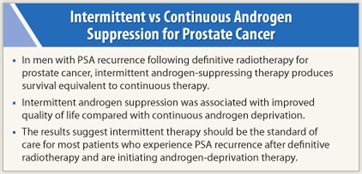Men with prostate cancer who receive intermittent courses of androgen-suppressing therapy can live as long as those who are treated with continuous therapy, according to results of a recently concluded study. Until now, standard treatment has consisted of continuous therapy, but this is expected to change as a result of these findings. Juanita  Crook, MD, FRCPC, of the University of British Columbia, presented the results of the phase IIII randomized trial conducted by the National Cancer Institute of Canada Clinical Trials Group (NCIC CTG PR.7/SWOG JPR.7/CTSU JPR.7/ UK Intercontinental Trial CRUKE/01/013), at the 2011 ASCO Annual Meeting.1
Crook, MD, FRCPC, of the University of British Columbia, presented the results of the phase IIII randomized trial conducted by the National Cancer Institute of Canada Clinical Trials Group (NCIC CTG PR.7/SWOG JPR.7/CTSU JPR.7/ UK Intercontinental Trial CRUKE/01/013), at the 2011 ASCO Annual Meeting.1
Conventional radiation therapy for localized prostate cancer is associated with a >30% incidence of prostate-specific antigen (PSA) failure, which is typically treated with hormonal therapy. Intermittent androgen suppression for PSA recurrence following surgical or radiation treatment for prostate cancer can delay hormone resistance and improve quality of life, but it was not known if this approach could prolong survival. This open-label, noninferiority randomized trial compared intermittent androgen suppression and continuous androgen deprivation to evaluate effects on survival and quality of life.
Study Design
Patients eligible for enrollment had rising PSA levels > 3.0 ng/mL more than 1 year post-radiotherapy and may have had up to 1 year of neoadjuvant or adjuvant androgen-deprivation therapy for localized prostate cancer. Stratification factors consisted of time since radiotherapy (> 1–3 vs > 3 years), initial PSA (< 15 vs > 15 ng/mL), and prior radical prostatectomy or androgen-deprivation therapy. Intermittent androgen suppression cycles consisted of 8 months of treatment with PSA-determined off-treatment periods. The primary endpoint was overall survival; secondary endpoints were hormone resistance, cholesterol/HDL/LDL, length of nontreatment periods, testosterone level, quality of life, and potency recovery.
Men who enrolled in this clinical trial had initially undergone definitive radiotherapy for their prostate cancer, either as primary treatment or as salvage for recurrence after radical prostatectomy, but subsequently developed elevated levels of PSA, indicating relapse. Nearly 1,400 men participated in the trial, which recruited patients from 1999 until 2005. Most enrolled patients were from Canada, but others were from the United States and United Kingdom.
Patients randomly assigned to the control group (n = 696) received continuous injections of a slow-release luteinizing hormone–releasing hormone (LHRH) blocker, usually at 3-month intervals. Those in the experimental group (n = 690) received the same drug but in 8-month treatment cycles, which were interrupted for extended “drug holidays” lasting several months to years. Patients were monitored for PSA levels every 2 months. When PSA levels rose to > 10 ng/mL while off treatment, LHRH blocker therapy was resumed for another 8-month cycle.
Major Results
 The trial follow-up period was stopped early (median follow-up, 6.9 years) because a planned interim analysis, reviewed by an independent data and safety monitoring committee, unequivocally demonstrated no difference in survival outcome between the two treatment groups. Median overall survival was 8.8 years on intermittent androgen suppression vs 9.1 years on continuous androgen deprivation (HR = 1.02; 95% CI = 0.86–1.21; P = .009 for noninferiority [HR ≥ 1.25 for intermittent androgen suppression vs continuous androgen deprivation]). Patients on the intermittent androgen suppression arm had more disease-related deaths (122 vs 97) and fewer disease-unrelated deaths (134 vs 146).
The trial follow-up period was stopped early (median follow-up, 6.9 years) because a planned interim analysis, reviewed by an independent data and safety monitoring committee, unequivocally demonstrated no difference in survival outcome between the two treatment groups. Median overall survival was 8.8 years on intermittent androgen suppression vs 9.1 years on continuous androgen deprivation (HR = 1.02; 95% CI = 0.86–1.21; P = .009 for noninferiority [HR ≥ 1.25 for intermittent androgen suppression vs continuous androgen deprivation]). Patients on the intermittent androgen suppression arm had more disease-related deaths (122 vs 97) and fewer disease-unrelated deaths (134 vs 146).
Patients receiving intermittent androgen suppression therapy had a reduced incidence of hot flashes, but rates of other adverse events, including myocardial events and osteoporotic fractures, were similar between the two groups. Full testosterone recovery was noted in 35% of men on the intermittent androgen suppression arm. Those receiving intermittent courses of the testosterone-suppressing drug reported better quality of life because of fewer or less intense side effects. Using a 10-point change from baseline score as a clinically meaningful criterion for quality-of-life change, intermittent androgen suppression patients had significant improvements in physical function, fatigue, urinary problems, hot flashes, desire for sexual activity, and erectile function compared with men on the continuous androgen deprivation arm (all P ≤ .01).
Other Implications
“These important findings also have significant economic and quality-of-life implications,” noted Dr. Crook. Patients on the intermittent therapy used only one-third the amount of drug as compared with continuous therapy, reducing both cost and toxicity. Adverse effects associated with androgen-suppressing therapy include hot flashes, sexual impotence, growth of breast tissue, insomnia, weight gain, worsening of diabetes, loss of muscle mass, and osteoporosis.
According to Dr. Crook, “For PSA recurrence after definitive radiation therapy, intermittent androgen suppression given as per the PR.7 algorithm is not inferior to continuous androgen deprivation with respect to overall survival.
“Intermittent androgen suppression should be the standard of care for most men with PSA recurrence after definitive radiotherapy—either primary or salvage post–radical prostatectomy—who are initiating androgen-deprivation therapy,” she concluded. ■
Disclosure: Dr. Crook has received honoraria and research funding from Abbott, AstraZeneca, and sanofi-aventis.
Reference
1. Crook JM, O’Callaghan CJ, Ding K, et al: A phase III randomized trial of intermittent versus continuous androgen suppression for PSA progression after radical therapy (NCIC CTG PR.7/SWOG JPR.7/CTSU JPR.7/ UK Intercontinental Trial CRUKE/01/013). 2011 ASCO Annual Meeting. Abstract 4514. Presented June 6, 2011.

